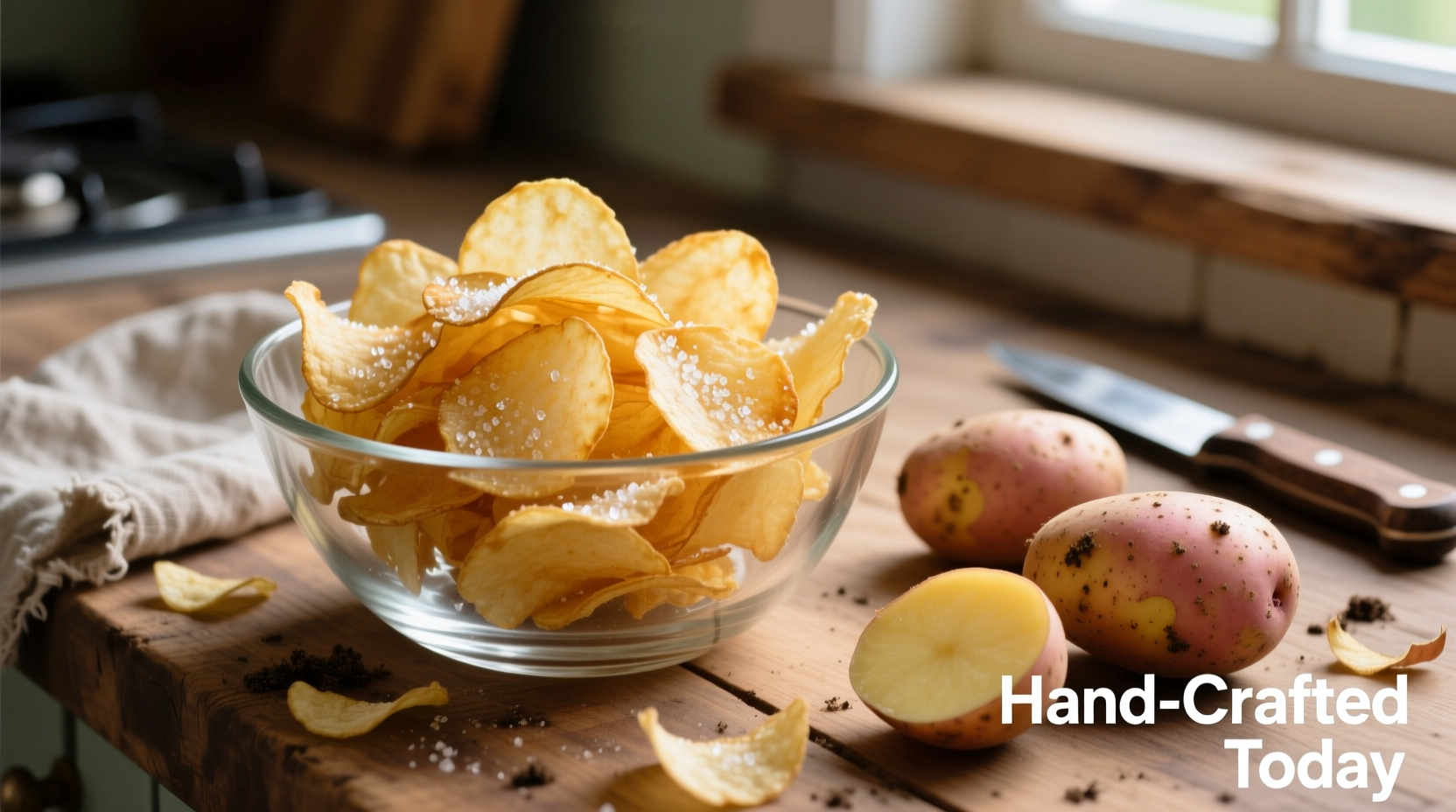Craving that perfect crunch without artificial ingredients? Homemade potato chips deliver superior freshness and customization while cutting out unnecessary additives. Forget expensive specialty equipment—with smart techniques anyone can create restaurant-quality chips using basic kitchen tools. This guide reveals the science-backed methods professional chefs use to achieve consistent crispness every time.
Essential Equipment Checklist
Before starting, gather these kitchen staples:
- Mandoline slicer (or sharp chef's knife for consistent 1/16-inch slices)
- Deep heavy-bottomed pot (Dutch oven ideal for temperature stability)
- Candy/deep-fry thermometer (critical for maintaining 350°F)
- Splatter screen (reduces mess and oil burns)
- Paper towel-lined baking sheet (for immediate draining)
Potato Selection Science
Not all potatoes create equally crispy chips. Starch content directly impacts texture:
| Potato Variety | Starch Content | Crispness Rating | Best For |
|---|---|---|---|
| Russet (Idaho) | High (22-24%) | ★★★★★ | Classic crispy chips |
| Yukon Gold | Medium (18-20%) | ★★★☆☆ | Thicker kettle-style chips |
| Red Potatoes | Low (15-17%) | ★☆☆☆☆ | Not recommended |
According to USDA agricultural research, Russets' higher starch-to-moisture ratio creates superior crispness through efficient water evaporation during frying (USDA Agricultural Research Service). Always select firm, blemish-free potatoes without green spots.
Preparation Protocol for Perfect Crispness
Skipping these steps causes soggy chips. Follow this sequence precisely:
- Wash thoroughly in cold water to remove surface starch
- Slice uniformly at 1/16-inch thickness using mandoline (wear cut-resistant glove)
- Soak in ice water for 30 minutes to remove excess starch
- Dry completely with clean kitchen towels (critical step!)
- Pat dry again with paper towels immediately before frying
Food science research shows that residual moisture causes oil temperature to drop significantly during frying, leading to oil absorption and sogginess (USDA National Institute of Food and Agriculture). Never skip the double-drying process.
Frying Temperature Timeline
Oil behavior changes dramatically during cooking. Monitor these phases:
- 300°F (149°C): Initial water evaporation - chips float but remain limp
- 325°F (163°C): Starch gelatinization begins - edges start curling
- 350°F (177°C): Optimal frying temperature - rapid crisping without burning
- 375°F+ (191°C+): Risk of burning - golden color develops in 60-90 seconds
Maintain 350°F throughout frying. Temperature fluctuations cause uneven cooking. Use a thermometer and adjust heat as needed. Fry in small batches (8-10 slices) to prevent temperature drops.
Safety First: Deep Frying Protocol
Home deep frying causes over 15,000 emergency room visits annually according to the Consumer Product Safety Commission. Follow these safety rules:
- Never leave hot oil unattended
- Keep children and pets away from cooking area
- Have lid nearby to smother potential flames (never use water)
- Fill pot no more than 1/3 full with oil
- Use long tongs for safe handling
Seasoning Techniques for Flavor Mastery
Add seasonings immediately after frying while chips are still oily:
- Classic salted: Fine sea salt while chips are hot
- Vinegar & salt: Spray with 50/50 malt vinegar/water mix before salting
- Spicy kick: Cayenne + smoked paprika (1/4 tsp per batch)
- Truffle aroma: Truffle salt + grated parmesan (add after cooling)
Professional chefs recommend applying seasonings in layers: 70% before draining, 30% after cooling for maximum adhesion. Avoid wet seasonings that compromise crispness.
Troubleshooting Common Issues
Solve these frequent problems with precision adjustments:
- Soggy chips: Inadequate drying or oil temperature too low. Solution: Double-dry slices and verify thermometer accuracy.
- Burnt edges: Slices too thin or oil too hot. Solution: Maintain 1/16-inch thickness and 350°F.
- Uneven cooking: Overcrowded pot. Solution: Fry max 10 slices per batch in quart of oil.
- Oily texture: Insufficient draining. Solution: Use wire rack instead of paper towels for better airflow.
Storage Secrets for Lasting Crispness
Homemade chips lose crispness faster than commercial versions due to lack of preservatives. Maximize freshness:
- Cool completely before storing (15-20 minutes on wire rack)
- Use airtight container with silica gel packet
- Store at room temperature away from humidity
- Consume within 24 hours for optimal texture
For extended storage, freeze in vacuum-sealed bags for up to 2 weeks. Re-crisp in 300°F oven for 3-5 minutes before serving.

When Homemade Isn't Ideal
Consider store-bought alternatives when:
- You lack proper ventilation (oil fumes can trigger smoke alarms)
- High humidity days (above 60% RH compromises crispness)
- Need large quantities (over 2 servings becomes time-prohibitive)
- Kitchen safety concerns exist (young children present)
For special occasions requiring large batches, oven-baked alternatives using parchment paper work better than attempting massive deep-frying operations.
How thin should I slice potatoes for chips?
Slice potatoes to exactly 1/16 inch (1.5mm) thickness using a mandoline slicer. Thicker slices won't crisp properly, while thinner slices burn easily. Consistent thickness ensures even cooking throughout the batch.
What's the best oil for frying potato chips?
Peanut oil provides the ideal balance of high smoke point (450°F) and neutral flavor. Canola and sunflower oil are good alternatives. Avoid olive oil (low smoke point) and butter (burns easily).
Why do my homemade chips turn out soggy?
Sogginess typically occurs from inadequate drying or incorrect oil temperature. Ensure potatoes are thoroughly dried after soaking and maintain oil at exactly 350°F throughout frying. Overcrowding the pot also causes temperature drops leading to oil absorption.
How long do homemade potato chips stay fresh?
Properly stored in an airtight container with silica gel, homemade chips maintain crispness for 24 hours at room temperature. For longer storage, freeze in vacuum-sealed bags for up to 2 weeks, then re-crisp in a 300°F oven for 3-5 minutes.
Can I make healthy baked potato chips instead?
Yes, but texture differs significantly. Toss thinly sliced potatoes with 1 tsp oil per batch, spread in single layer on parchment-lined baking sheet, and bake at 400°F for 15-20 minutes flipping once. Baked chips lack the crispness of fried versions but reduce fat content by 60%.











 浙公网安备
33010002000092号
浙公网安备
33010002000092号 浙B2-20120091-4
浙B2-20120091-4